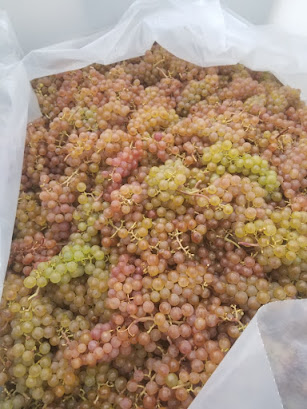Author: Annie Klodd, Extension Educator - Fruit and Vegetable Production
In this week's update:
- Sorting apples for quality and size
- Which strawberry leaf disease is this?
- Itasca grape harvest starts!
- Time to seed cover crops in orchards and vineyards
Sorting apples for quality and size
 |
| Recording marketability data of SweeTango apples. Photo: Annie Klodd |
I will have a more detailed article on this topic in a few days. However, I wanted to briefly go ahead and point out a few things about selling early season apples, and how to sort them based on marketability qualities.
Growers selling direct-to-consumer have much more liberty when it comes to sorting and marketing their apples. In contrast, those selling wholesale must follow guidelines set by the buyer, which typically follow USDA grading standards.
However, those licensed to grow club varieties including First Kiss and SweeTango have agreed to follow specific sets of quality standards. If the fruit do not meet the quality standards, they should not be sold as First Kiss or SweeTango, even at farmers' markets or on-farm. For questions on First Kiss licensing, contact UMN's Office for Technology Commercialization. For questions on SweeTango licensing, contact Pepin Heights Orchard. See this article for more information.
Minnesota growers selling direct-to-consumer and growing varieties other than First Kiss and SweeTango can decide their own quality standards. However, please remember that selling under-ripe or blemished fruit for premium prices can impact the grower's reputation and the customer's perception of the variety. For example, selling a tart, underripe Honeycrisp at full price may make a customer wonder "what's the fuss?" about this variety and not buy it again.
When sorting fruit for on-farm on farmers' market sales, growers may elect to sell their highest quality fruit for higher prices, and blemished, discolored, small but still usable fruit for lower prices. Suggested traits to sort by are size, % red coloring, and presence or absence of blemishes (i.e. split skin, insect bites, sunburn, webbed russetting). Diseased or split fruit should be culled or sold for cider, depending on the type and extent of the damage.
 |
| Three SweeTango apples, size small, medium, and large (left to right). Photo: Annie Klodd. |
 |
| An apple with split skin at a lenticel, which will be used immediately for cider, or culled. Photo: Annie Klodd. |
Which strawberry leaf disease is this?
 |
| Strawberry leaf spot. Photo: Annie Klodd. |
In Minnesota, strawberry leaf diseases are very common. These diseases include leaf spot, leaf scorch, and leaf blight. Powdery mildew also has leaf symptoms that can be confused with the other three diseases. They are challenging to distinguish by sight, but experience and a good fruit disease guide helps growers tell them apart in the field.
See this article by Ohio State University Extension for more detailed descriptions of these diseases.
Strawberry leaf scorch causes irregularly shaped, purple and brownish blotches on the upper surface of the leaf. Older leaves are more susceptible than younger leaves.
Strawberry leaf spot causes round spots that are originally deep purple, and then turn white in the center. This disease can also spread to the fruit.
Strawberry leaf blight first causes one or a few small, circular spots per leaflet, then spreads into a V-shaped, brown lesion that grows inward along a vein of the leaflet.
Early season control is important for these diseases if they become severe. However, disease resistant varieties are a better, more proactive defense against leaf diseases.
Itasca grape harvest starts!
 |
| Itasca grapes during the 2019 harvest at Les Curry's vineyard in Amboy, MN. Photo: Les Curry. |
A handful of Minnesota vineyards have already harvested their Itasca grapes, including at least one winery west of Minneapolis. The Itasca grapes at the UMN Horticultural Research Center in Excelsior, however, are still a few days away from harvest, with a brix of 25.2, pH 3.11, and titratable acidity (TA) of 10.8 g/L. The pH must continue to rise and the TA decrease before they are ready for harvest. Itasca is the newest cultivar released by UMN, in 2017. For information on when to harvest your cold climate grape varieties, contact the UMN Grape Breeding and Enology Program's research enologist.
Time to seed perennial cover crops in orchards and vineyards
 |
| Keepsake Cidery's orchard has in-row perennial cover crops under the trees, including grasses and forbs. Photo: Annie Klodd. |
Growers wishing to seed perennial cover crops in fruit crops should seed them now, or within the next two weeks.
Planting cover crops in mature orchards and vineyards can help out-compete weeds within and between the rows, while introducing other benefits such as biodiversity, soil health, and N-fixation. Additionally, fescue grass species have fibrous roots that can add calcium to the soil and prevent erosion.
According to UMN Extension's new turf Extension Educator, Maggie Reiter, mixing in 20-30% clover to a fescue grass seed mix is helpful to increase nitrogen fixing in the soil. Since clover grows more aggressively than fescue, the percentage should stay low to allow space for the fescues to establish properly. Creeping red fescue is a good choice for planting underneath trees and vines (within the rows) because it stays short. For more information on perennial cover crop species, see the NRCS or SARE websites.
Note: While I am a big supporter of using perennial cover crops in orchards and vineyards, they should not be planted directly in-row for newly established trees/vines. New trees and vines do not compete well with other plants, so planting in-row cover crops too soon can drastically stunt plant growth even if water and soil nutrients are plentiful. Wait 2-3 years, or until the plants are well-established and vigorous, before planting in-row cover crops; keep weeds down during this time as well.
Comments
Post a Comment